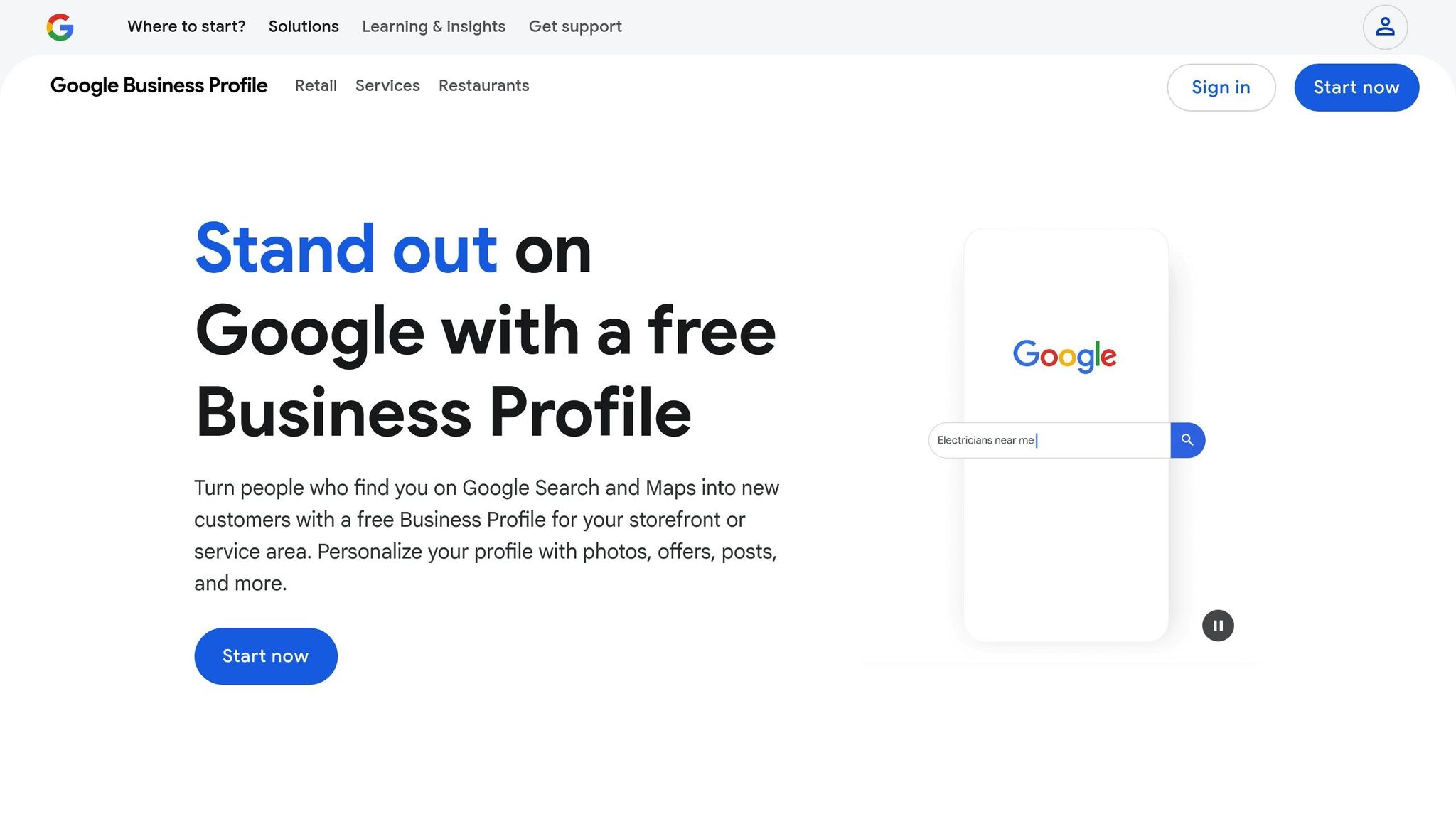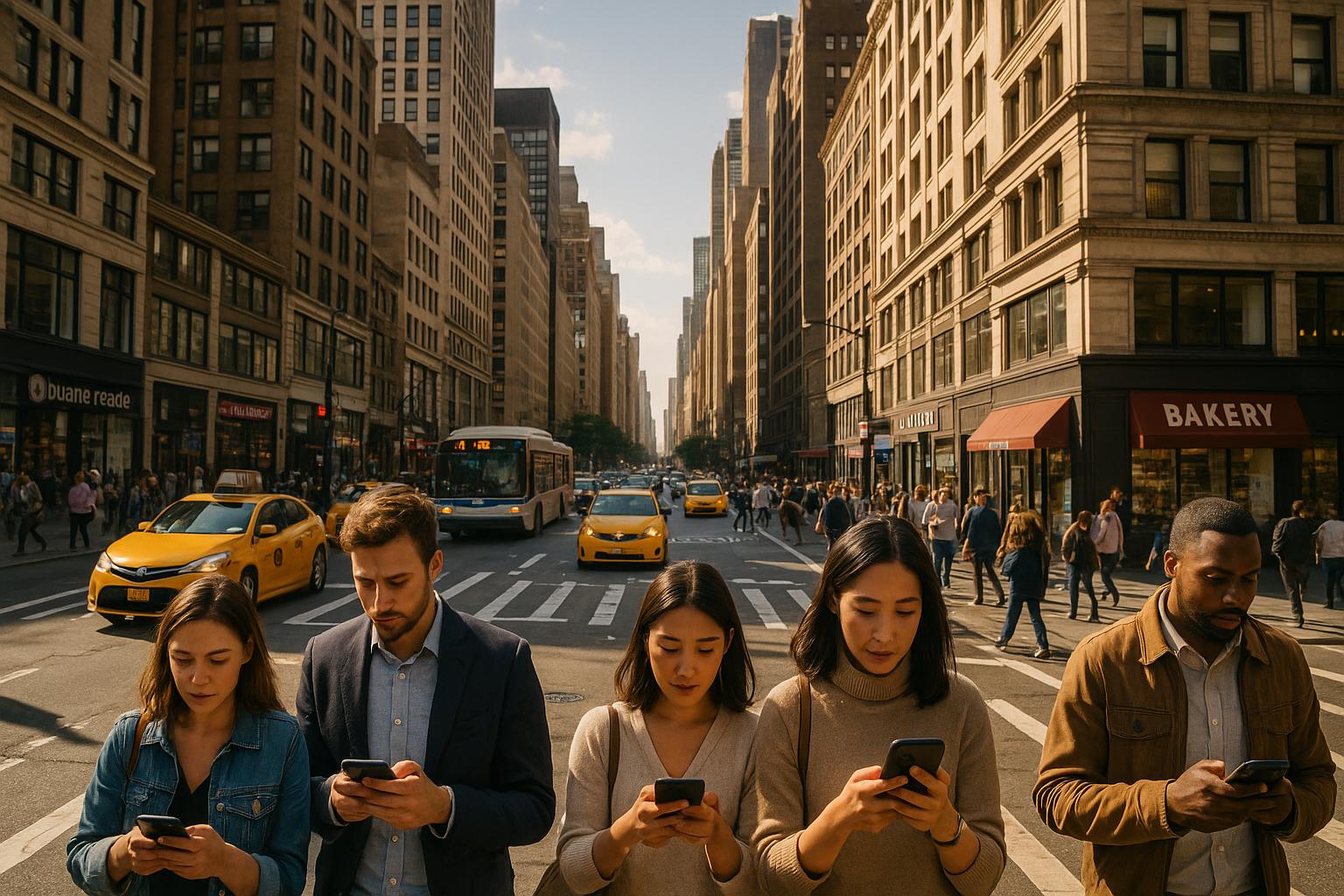In NYC, where speed and convenience dominate, optimizing your mobile presence is critical to connecting with users who are constantly on the move. Here’s what you need to know to succeed:
- Mobile Optimization: Ensure your website is fast, responsive, and user-friendly. Over 92% of searches in NYC happen on smartphones, and 53% of users leave sites that take more than 3 seconds to load.
- Local SEO: Set up and maintain an accurate Google Business Profile. Use NYC-specific keywords like “pizza Midtown” or “urgent care Brooklyn” to target local audiences effectively.
- Page Speed: Compress images, enable caching, and minimize HTTP requests. Fast-loading sites rank better and keep users engaged.
- Responsive Design: Your site should adapt to any screen size, with touch-friendly navigation for users juggling busy city life.
- Local Backlinks: Build connections with NYC-based publications, blogs, and directories to improve local search rankings.
- Accurate Business Info: Keep your hours, address, and contact details up-to-date across all platforms to avoid losing customers.
- Voice Search: Optimize for conversational queries like “coffee shop near me” to capture hands-free searchers.
NYC’s fast-paced lifestyle demands quick, relevant results. By focusing on mobile-first strategies, local relevance, and user experience, your business can thrive in the city that never stops.
Optimize Mobile SEO: Key Tips & Common Mistakes!
1. Optimize Your Website for Mobile-First Indexing
Google has prioritized mobile-first indexing since 2016, and for businesses in NYC, this could make or break your online visibility.
Mobile-Friendliness and Responsiveness
Your website needs to perform seamlessly across all devices, from the latest iPhone to older Android models. A responsive design is key – it ensures your site automatically adjusts to fit any screen size, with touch-friendly buttons and text that’s easy to read without zooming.
Here’s why this matters: 92% of searches in NYC are conducted on smartphones, and over 75% of New Yorkers primarily access the internet through their phones. If your site isn’t mobile-optimized, you could be missing out on a massive audience.
To meet user expectations, focus on features like collapsible menus and navigation designed for touch. In a fast-paced city like NYC, users demand quick, intuitive interactions. A responsive site not only meets these expectations but also encourages visitors to stay longer and engage more.
Impact on User Experience and Engagement
Mobile optimization is directly tied to user experience. Here’s a striking fact: 53% of mobile users will leave a site that takes more than three seconds to load. In NYC, where every second counts, that threshold is likely even shorter.
By providing a smooth, fast-loading mobile experience, you can keep visitors on your site longer, reduce bounce rates, and send positive signals to Google. This, in turn, helps improve your search rankings.
Effectiveness in Improving Mobile SEO Rankings
Mobile optimization also plays a critical role in improving Core Web Vitals – Google’s metrics for loading speed, interactivity, and visual stability. These factors are essential for capturing the attention of New Yorkers who expect instant results.
Additionally, optimizing for mobile enhances your site’s compatibility with voice search, which is increasingly used for local queries. For instance, when someone asks their phone, “Where’s the nearest coffee shop?” while walking through Times Square, your mobile-optimized site can deliver a fast, accurate answer.
For NYC businesses, mobile-first optimization isn’t just a technical update – it’s a strategy that drives both user engagement and better search performance.
2. Focus on Mobile Page Speed
Why It Matters for NYC’s On-the-Go Audience
Picture this: you’re navigating NYC’s bustling streets or waiting for the subway with a spotty connection. You grab your phone to look something up, but the website takes forever to load. Frustrating, right? That’s the reality for many of NYC’s mobile users who are constantly on the move – whether they’re between meetings, commuting, or dealing with network hiccups. For businesses, having a fast-loading mobile site isn’t just nice to have – it’s essential. A slow site risks losing potential customers before they even get a chance to engage.
How It Impacts User Experience and Engagement
The speed of your mobile site can make or break the user experience. Quick-loading sites keep visitors around longer, reducing bounce rates and encouraging them to explore more pages. This increased interaction not only improves conversions but also sends positive signals to Google. And when Google notices, it can help push your site higher in search results – a win-win for both engagement and visibility.
The Connection Between Speed and Mobile SEO Rankings
Here’s where mobile page speed really pays off: better rankings. Google’s Core Web Vitals – metrics like Largest Contentful Paint (LCP) and First Input Delay (FID) – are critical for mobile SEO. Sites with an LCP under 2.5 seconds and an FID under 100 milliseconds tend to perform better in search results. Faster load times mean happier users and, ultimately, better positioning on Google.
To boost your mobile page speed, start with these steps:
- Compress images to reduce load times.
- Enable browser caching so returning visitors can load pages faster.
- Minimize HTTP requests by combining CSS and JavaScript files.
For NYC’s fast-moving market, Accelerated Mobile Pages (AMP) are a game-changer. These pages load almost instantly and often earn prime placement in Google’s mobile search carousel. For industries like restaurants, retail, and local services, where speed is everything, AMP can make a huge difference in capturing attention and driving traffic.
3. Set Up Your Google Business Profile

Relevance to NYC’s Local Audience
Your Google Business Profile acts as a digital storefront, especially for NYC’s mobile-savvy customers. Picture this: someone in Midtown searches for "pizza near me" or a Brooklyn resident looks up "urgent care Brooklyn" on their phone. Google pulls information straight from these profiles to display the most relevant local results. For businesses in NYC, where competition is fierce, your profile often serves as the first impression for potential customers actively searching for services nearby.
This profile delivers the essentials – address, phone number, hours, and reviews – right when people need them. In a city where decisions are made on the go, having a complete and accurate profile can mean the difference between gaining a new customer or losing them to a competitor who appears more prominently in local searches. It’s a simple but powerful way to connect with NYC customers instantly.
Mobile-Friendliness and Responsiveness
Google Business Profiles are tailor-made for mobile users, making them ideal for NYC’s fast-paced, on-the-move crowd. With just a tap, customers can call your business, get directions, or browse photos. This quick, seamless experience aligns perfectly with the needs of busy New Yorkers who often make decisions in the moment – whether they’re choosing a lunch spot or finding a nearby service.
Impact on User Experience and Engagement
An optimized profile doesn’t just provide information; it enhances the entire mobile experience. Including high-quality photos, accurate hours, and recent reviews ensures users have everything they need at a glance. Features like Questions & Answers and Google Posts allow you to keep your profile updated with fresh content, answer common inquiries, and share timely updates. These interactive elements not only make your business more appealing but also help you stand out in local search results.
Effectiveness in Improving Mobile SEO Rankings
A well-maintained Google Business Profile can significantly boost your local search visibility. When your profile is complete and regularly updated, Google is more likely to feature your business in the Local Pack – the top three local results that dominate mobile search screens. For NYC businesses, securing this prime spot is key to staying ahead in crowded markets.
Regular updates, like adding new photos, collecting recent reviews, and posting timely content, signal to Google that your business is active and relevant. Increased engagement – whether through clicks, calls, or requests for directions – further reinforces your business’s value to local searchers. This, in turn, improves your overall local search rankings, ensuring you’re visible to NYC’s mobile users when they need your services most.
To make your profile as effective as possible, focus on the details. Choose specific and accurate business categories, write clear descriptions of your services, and keep your NAP (Name, Address, Phone) information consistent across all platforms. These steps help Google understand your business better and show it to the right audience at the right time.
4. Target NYC-Specific Keywords
Relevance to NYC’s Local Audience
Once you’ve optimized for mobile-first indexing and speed, the next step is zeroing in on NYC-specific keywords. These keywords directly connect your business to local searchers. Think about it – when someone in Manhattan searches for "coffee shop near Wall Street" or a Queens resident types in "plumber Astoria NY", they’re signaling an immediate intent to visit or contact a nearby business.
New Yorkers often search in hyper-local terms, combining services with neighborhood names, subway stops, or landmarks. For example, phrases like "Italian restaurant Little Italy" or "pasta near Union Square" are far more effective than generic terms. This approach lets you fine-tune your keyword strategy to match the city’s dynamic and location-specific search habits.
NYC’s geography adds another layer of complexity to search behavior. A Brooklyn Heights resident won’t search the same way as someone from the Upper East Side, even if they’re looking for similar services. Understanding these subtle differences helps you create content that resonates with each neighborhood’s audience and their unique mobile search patterns.
Mobile-Friendliness and Responsiveness
New Yorkers are constantly on the move, which means they favor short, direct keywords. A phrase like "pizza Midtown" is more likely to be used than "best pizza restaurants in Midtown Manhattan." Speed and simplicity are key when targeting mobile users in the city.
Voice search is also a game-changer for NYC businesses. With so many people navigating the city hands-free, conversational keyword patterns are becoming the norm. Phrases like "find a pharmacy near me" or "urgent care open now Brooklyn" are common. By focusing on these natural, voice-driven search terms, you can better meet the needs of New Yorkers who are on the go.
The "near me" trend is especially powerful in NYC’s dense environment. Location-based searches drive phrases like "gym near me", "dry cleaner near me", or "late night food near me." These searches are essential for connecting with mobile users looking for immediate solutions in their area.
Impact on User Experience and Engagement
Targeting NYC-specific keywords isn’t just about rankings – it’s also about delivering an excellent user experience. When your content aligns with what mobile searchers are looking for, they’re more likely to stay on your site, call, visit, or make a purchase. Matching search intent builds trust and keeps users engaged.
Creating neighborhood-specific landing pages can make a big difference. For instance, having separate pages for "dental services Williamsburg" and "dental services Park Slope" allows you to cater to the unique needs and characteristics of each community. This level of personalization shows visitors that you understand their local context.
Time-sensitive keywords are another effective tool. Phrases like "24 hour pharmacy Manhattan", "weekend brunch Upper West Side", or "late night delivery Tribeca" reflect NYC’s non-stop lifestyle and attract users with immediate needs. These terms not only drive engagement but also capture the essence of the city’s fast-paced energy.
Effectiveness in Improving Mobile SEO Rankings
NYC-specific keywords can be highly competitive, but they also offer great opportunities when targeted strategically. The trick lies in finding the balance between search volume and competition. While broad terms like "restaurant NYC" are tough to rank for, more specific phrases like "authentic dim sum Chinatown" often show stronger intent and face less competition.
Long-tail keywords are another goldmine. Phrases such as "emergency locksmith Upper East Side 24/7" may have lower search volumes, but they attract users who are ready to take action. These specific terms often lead to higher conversions.
Don’t overlook seasonal keywords either. Terms like "outdoor dining Soho summer", "holiday shopping Fifth Avenue", or "tax preparation services NYC April" align with predictable trends and can help you capture traffic during peak times.
For maximum impact, combine your location keywords with service-specific terms. Instead of cramming keywords into your content, integrate them naturally into helpful, well-written material. This approach not only serves your audience but also signals relevance to search engines, boosting your visibility in NYC’s competitive market.
5. Use Responsive Design
Mobile-Friendliness and Responsiveness
Responsive design ensures your website adapts seamlessly across devices, from compact smartphone screens to expansive desktop monitors. This is especially crucial in NYC, where people constantly switch between devices – checking your site on their phones during a subway ride, then revisiting it on a laptop at work.
Key elements of responsive design include flexible grids, scalable images, and touch-friendly buttons. For instance, your navigation menu should transform into a hamburger menu on smaller screens, while text adjusts automatically for readability. CSS media queries play a vital role here, detecting screen sizes and adjusting layouts – like converting a three-column desktop layout into a single-column mobile view. This adaptability ensures NYC users have a smooth browsing experience, no matter where their day takes them.
Relevance to NYC’s Local Audience
New Yorkers browse websites in all kinds of environments – crowded subways, bustling streets, and dimly lit cafes. Your responsive design must consider these real-life scenarios. For example, designs should work well in low-light settings and on screens with varying brightness levels.
NYC’s diverse population also means catering to various accessibility needs. Features like adjustable font sizes and screen reader compatibility are essential for inclusivity, ensuring everyone can access your site.
And don’t forget the weather! During NYC’s cold winters, people often use their phones while wearing gloves. To accommodate this, your design should include larger touch targets (at least 44 pixels), making it easier for gloved fingers to navigate. These small adjustments can make a big difference – turning frustrating experiences into completed transactions.
Impact on User Experience and Engagement
Responsive design doesn’t just improve how your site looks; it enhances how users interact with it. A well-designed responsive site keeps mobile users engaged, reducing bounce rates significantly. When your site loads properly on any device, visitors are more likely to stay longer and explore further. This improved engagement sends positive signals to search engines, which can help boost your rankings in mobile search results.
For NYC businesses, optimizing forms is especially important. Whether someone is booking a reservation, scheduling a service, or making a purchase, forms should work effortlessly on mobile. Features like auto-fill, simplified field layouts, and mobile-friendly payment options can dramatically increase conversions.
In a city as fast-paced as NYC, speed is everything. Prioritize loading above-the-fold content first so users can start interacting with your site immediately, even as other elements load in the background. This approach keeps users engaged and prevents them from leaving out of frustration.
Effectiveness in Improving Mobile SEO Rankings
Google’s mobile-first indexing means your mobile site version is the primary factor for ranking and indexing. Responsive design ensures your desktop and mobile versions share the same URL structure, avoiding duplicate content issues and preserving your SEO authority.
A unified responsive design also simplifies structured data integration and reduces layout shifts – both essential for ranking well in mobile searches. Structured data helps search engines better understand your business information, reviews, and local details, which is especially important in NYC’s competitive local search landscape.
Page speed optimization becomes far more efficient with a responsive design. Instead of juggling separate mobile and desktop versions, you can focus on optimizing one adaptable design. For a city that thrives on speed and efficiency, this streamlined approach not only maintains your SEO credibility but also delivers the fast, seamless experience NYC users expect.
6. Design for Touch Navigation
Mobile-Friendliness and Responsiveness
Creating a seamless touch navigation experience means designing for real-world use. Make sure buttons, links, and other interactive elements are spaced out enough to avoid accidental taps. Clear labels and intuitive layouts are key, especially for users navigating with one hand while on the go.
Relevance to NYC’s Local Audience
In a fast-paced city like New York, people are often juggling their phones while walking crowded sidewalks or riding packed subway cars. A touch-friendly navigation system ensures users can quickly and easily access what they need, even in these hectic environments. By minimizing errors and enhancing usability, you’re not just improving functionality – you’re making your site more relevant for the city’s unique lifestyle. This kind of thoughtful design fits perfectly with a mobile-first approach, driving better engagement and visibility in search results.
Impact on User Experience and Mobile SEO
Responsive design lays the groundwork, but touch navigation takes it a step further by refining the mobile experience. When users can navigate easily and efficiently, satisfaction goes up – and so does your site’s performance in search rankings. Search engines reward websites that provide a smooth, user-friendly mobile experience. By prioritizing intuitive navigation, you’re improving engagement metrics, which is especially important in a competitive market like NYC.
A well-designed touch interface isn’t just about convenience – it’s a smart move for better SEO and stronger user engagement.
7. Build Local NYC Backlinks
Why Local Backlinks Matter in NYC
Local backlinks are like digital bridges connecting your business to NYC’s online community. When your site is linked by local publications, business directories, or neighborhood blogs, search engines see your business as part of the city’s ecosystem. This is especially important for mobile users who often search with location-based intent – think "coffee shop near me" or "best pizza in Brooklyn."
Focus on earning links from trusted NYC-based sources like Time Out New York, Gothamist, Chamber of Commerce websites, or borough-specific associations. These links signal to search engines that your business is genuinely rooted in NYC, not just trying to tap into its market. These local connections can also pave the way for more authoritative backlinks, which further strengthen your mobile rankings.
Boosting Mobile SEO with Local Links
Local backlinks are particularly powerful for improving mobile search rankings. Why? Because mobile users often rely on "near me" searches or specific location-based queries. High-quality links from well-known NYC sites not only increase your authority in local search results but also help your business stand out on mobile devices.
One key tip: ensure the sites linking to you are mobile-friendly. Search engines consider the mobile usability of linking sites when assessing the quality of those links. A mobile-friendly link source can help amplify your visibility in mobile search results.
Enhancing User Experience Through Local Connections
Backlinks from trusted NYC sources don’t just help with rankings – they also drive highly relevant traffic to your site. Visitors coming from these links are often familiar with your local market and have a higher intent to engage, making them more likely to convert.
To build these valuable connections, think beyond the digital realm. Engage with local influencers, journalists, and community groups. Participate in neighborhood events, sponsor local activities, or contribute expert insights to NYC publications. These efforts naturally create opportunities for backlinks while strengthening your presence in the community.
If you’re looking for more ideas on building a strong local backlink strategy, check out our link building services.
8. Keep Business Information Current
Staying on top of your business information does more than just keep things organized – it builds trust and boosts your local search performance, especially when paired with mobile optimization strategies.
Relevance to NYC’s Local Audience
New York City moves at lightning speed, and your customers expect the same from you. Picture this: someone is rushing through Penn Station or strolling down Fifth Avenue, searching for your business on their phone. If your hours are outdated, your phone number is wrong, or your address leads them to the wrong spot, they’re not sticking around – they’ll head straight to your competitor.
To avoid this, make sure your business details are consistent across all platforms, including Google Business Profile, Yelp, Apple Maps, Facebook, and NYC-specific directories. In a city as competitive as NYC, even small inconsistencies can drive potential customers elsewhere.
Seasonal changes are another big deal for NYC businesses. If your restaurant’s outdoor seating is only available in the warmer months, update your listings to reflect that. Retailers should also adjust their hours for holidays or events like Fashion Week. Keeping these details accurate ensures your customers know exactly what to expect.
Impact on User Experience and Engagement
NYC mobile users are all about speed and accuracy. When they tap the "call" button on your listing, they expect to reach you. When they click "directions", they need to arrive at your location without a hitch. Incorrect details create unnecessary frustration, and in a fast-paced city, that’s all it takes for someone to move on.
Imagine this scenario: your listing says you’re open, but when a customer shows up, your doors are locked. Not only do they leave with a sour impression, but they might also leave a negative review, damaging your reputation.
Real-time updates are also critical during unexpected situations. If a water main break forces you to close early (an all-too-common NYC issue), updating your Google Business Profile can prevent disappointed customers and bad reviews. The same goes for temporary relocations, construction delays, or special event hours.
Effectiveness in Improving Mobile SEO Rankings
Keeping your business information accurate doesn’t just help customers – it helps search engines trust you too. Google’s algorithm prioritizes businesses with consistent details across platforms. When your name, address, and phone number (NAP) match everywhere, it signals reliability, which can improve your local search rankings.
User behavior also plays a role. If people keep calling a wrong number or show up at the wrong location, those negative interactions hurt your rankings. On the flip side, when customers find your accurate listing and have a seamless experience, search engines take that as a positive signal.
Regular updates also show search engines that your business is active. Adding fresh photos, tweaking service descriptions, or keeping your hours current signals engagement, which can boost your visibility in mobile searches. This is especially important for location-based queries, which are common among NYC’s mobile-first audience.
To stay on top of things, conduct regular audits of your listings. Check platforms like Google Business Profile, social media, and major directories for discrepancies in hours, contact info, and descriptions. Consistency across all platforms not only strengthens your SEO but also ensures NYC’s busy, on-the-go customers can find and connect with you when they need to.
Conclusion
Reaching NYC’s mobile audience isn’t just about having a phone-friendly website – it’s about creating an experience that keeps up with the city’s relentless pace. The strategies outlined here work together to help your business thrive in this competitive market.
A mobile-first, responsive design ensures your site loads quickly and looks polished on any device. In a city where every second counts, slow-loading pages or clunky navigation can drive potential customers straight to your competitors.
Local SEO strategies tie your business to NYC’s neighborhood-centric culture. Setting up your Google Business Profile, using NYC-specific keywords, and securing local backlinks help your business appear in searches like "near me" or for specific boroughs. These aren’t just technical tweaks – they’re how you become part of the local fabric. And when paired with a mobile-first approach, these efforts work seamlessly to connect you with your audience.
By combining local SEO and user-friendly design, you ensure your business shows up where and when people need it most. Fast load times, accurate contact information, and up-to-date details prevent the frustration of outdated listings, ensuring a smooth experience for customers who are ready to engage with your business.
These strategies don’t work in isolation – they build on each other. Better rankings lead to greater visibility, putting your business in front of NYC’s millions of mobile users who are actively searching for services. Together, they create a smooth, cohesive experience that aligns with the city’s fast-paced lifestyle.
NYC’s mobile-first behavior is a fact of life. Whether deciding where to eat, finding services during a commute, or researching purchases while standing in line, people rely on their phones to make quick decisions. Your mobile SEO strategy needs to deliver exactly what they’re looking for, right when they need it.
In NYC, convenience is king. When your mobile presence is optimized for speed, accuracy, and local relevance, you’re not just climbing search rankings – you’re becoming the go-to choice for customers who value their time and demand seamless digital experiences.
These eight strategies are your blueprint for mobile SEO success in NYC. Implement them thoughtfully, and you’ll turn mobile searches into loyal customers, building a mobile presence that stands out in the city that never slows down.
FAQs
How can I use NYC-specific keywords to boost my mobile SEO?
To boost your mobile SEO with NYC-focused keywords, prioritize location-specific terms that match the way people in New York search. Think about incorporating phrases like "New York City", names of boroughs such as Brooklyn or Manhattan, and even hyper-local neighborhood names.
Another effective strategy is to create content that highlights local events, landmarks, or trending NYC topics. This approach not only makes your site more relevant in local searches but also resonates with the dynamic and fast-moving NYC audience. Use these keywords naturally in your titles, meta descriptions, and throughout your site to maximize their impact.
What are the key features of responsive design that improve the mobile browsing experience for NYC users on the go?
Responsive design makes sure your website works perfectly across all screen sizes, offering a seamless experience for mobile users. This includes layouts that automatically adjust to fit different devices, readable fonts that don’t require zooming in, and navigation designed for touch, like tappable menus and buttons.
For the fast-moving crowd in NYC, site speed is equally important – pages need to load fast to keep users from bouncing. A thoughtfully designed responsive site not only improves usability but also helps capture and hold the attention of busy, on-the-go users exploring the city.
Why is keeping your business information accurate across platforms essential for mobile SEO in NYC?
Keeping your business information accurate and consistent across all platforms is crucial for mobile SEO success in NYC. In a city as fast-paced as New York, mobile users need quick access to details like your location, contact info, and operating hours.
When your information is consistent, it not only helps customers find you easily but also strengthens trust with search engines. This can boost your local search rankings, making your business more visible to potential customers on the go. Clear and precise details mean fewer missed connections and happier customers.




